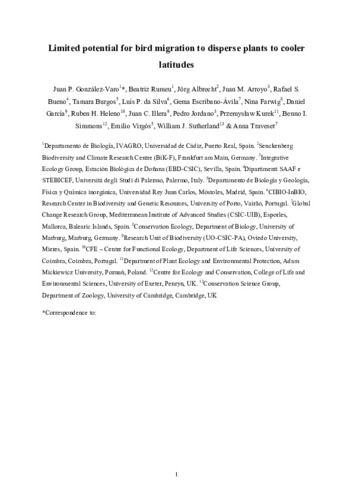Limited potential for bird migration to disperse plants to cooler latitudes
Fecha de publicación:
Versión del editor:
Citación:
Descripción física:
Resumen:
Climate change is forcing the redistribution of life on Earth at an unprecedented velocity1,2. Migratory birds are thought to help plants to track climate change through long-distance seed dispersal3,4. However, seeds may be consistently dispersed towards cooler or warmer latitudes depending on whether the fruiting period of a plant species coincides with northward or southward migrations. Here we assess the potential of plant communities to keep pace with climate change through long-distance seed dispersal by migratory birds. To do so, we combine phenological and migration information with data on 949 seed-dispersal interactions between 46 bird and 81 plant species from 13 woodland communities across Europe. Most of the plant species (86%) in these communities are dispersed by birds migrating south, whereas only 35% are dispersed by birds migrating north; the latter subset is phylogenetically clustered in lineages that have fruiting periods that overlap with the spring migration. Moreover, the majority of this critical dispersal service northwards is provided by only a few Palaearctic migrant species. The potential of migratory birds to assist a small, non-random sample of plants to track climate change latitudinally is expected to strongly influence the formation of novel plant communities, and thus affect their ecosystem functions and community assembly at higher trophic levels.
Climate change is forcing the redistribution of life on Earth at an unprecedented velocity1,2. Migratory birds are thought to help plants to track climate change through long-distance seed dispersal3,4. However, seeds may be consistently dispersed towards cooler or warmer latitudes depending on whether the fruiting period of a plant species coincides with northward or southward migrations. Here we assess the potential of plant communities to keep pace with climate change through long-distance seed dispersal by migratory birds. To do so, we combine phenological and migration information with data on 949 seed-dispersal interactions between 46 bird and 81 plant species from 13 woodland communities across Europe. Most of the plant species (86%) in these communities are dispersed by birds migrating south, whereas only 35% are dispersed by birds migrating north; the latter subset is phylogenetically clustered in lineages that have fruiting periods that overlap with the spring migration. Moreover, the majority of this critical dispersal service northwards is provided by only a few Palaearctic migrant species. The potential of migratory birds to assist a small, non-random sample of plants to track climate change latitudinally is expected to strongly influence the formation of novel plant communities, and thus affect their ecosystem functions and community assembly at higher trophic levels.
ISSN:
Patrocinado por:
Barcoding data were obtained within an Individual Fellowship from the Marie Sklodowska-Curie Actions (H2020-MSCA-IF-2014-656572: MobileLinks) and supported by a GRUPIN grant from the Regional Government of Asturias (IDI/2018/000151). ‘King Jaume I’ awarded to A.T. supported data collation during two postdoctoral contracts. J.P.G.-V. is supported by a Spanish ‘Ramón y Cajal’ fellowship (RYC-2017-22095) and a grant from the Spanish MICINN (PID2019-104922GA-I00/AEI/10.13039/501100011033). B.R. is supported by a Spanish ‘Juan de la Cierva Incorporación’ fellowship (IJCI-2017-33475). R.H.H. is funded by the Portuguese Foundation for Science and Technology (UID/BIA/04004/2020). B.I.S. is supported by a Royal Commission for the Exhibition of 1851 Research Fellowship. W.J.S. is funded by Arcadia.
Colecciones
- Artículos [37556]
- Biología de Organismos y Sistemas [776]
- Investigaciones y Documentos OpenAIRE [8424]
Ficheros en el ítem





